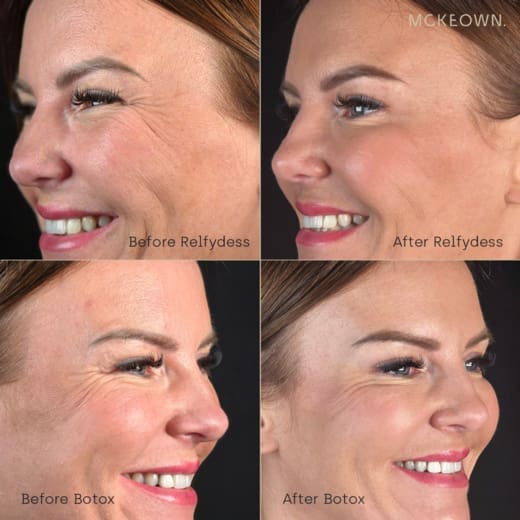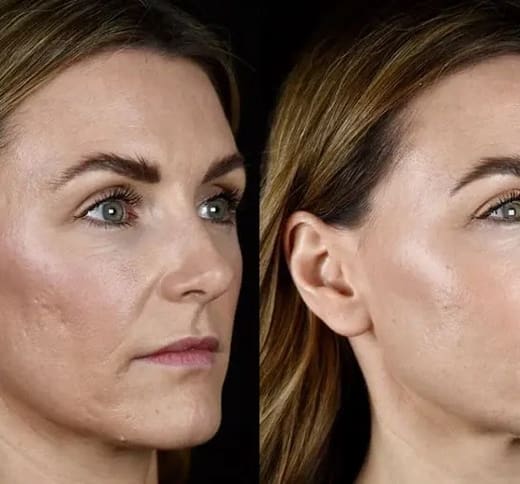McKeown Medical
167 Bath Street, Glasgow, G2 4SQ
Date posted — 5.10.24
As always in medicine, the best treatment is prevention – which means avoiding the sun as much as possible and covering up and protecting the skin with SPF when it’s not possible to avoid sun exposure.
But let’s assume you maybe take care of your skin now, but you weren’t so good in your younger years, and you’ve got some historic sun damage that you want to get rid of.
How do you go about getting rid of that old sun damage on the face and body?
The mainstay of treating sun damage is laser treatment, and there are three main categories of lasers you can use to treat sun damage.
The first category is ablative – which means that it removes tissue from the surface of the skin.
The ablative lasers can then be subdivided into fully ablative lasers – which remove the entire surface of the skin – and fractional ablative lasers, which remove only a fraction of the skin’s surface.
The final category is the non-ablative lasers, which don’t remove any tissue from the skin’s surface.
Let’s start with the non-ablative devices.
My favourite non-ablative way to treat sun-damaged skin anywhere on the body (we most commonly treat it on the face, but we can treat it pretty much anywhere on the body) is broadband light.
Ok, so technically, this is not a laser because it uses more than one wavelength of light. But let’s forget about the physics and think of it as a laser.
Broadband light (BBL) is an excellent technology for shattering pigments in the skin, which gets rid of the brown spots or age spots or areas of hyperpigmentation if we want to use their technical name.
BBL is also excellent for reacting with the red pigment in blood vessels, causing the blood vessels to close down and clear patches of redness.
It is also an excellent stimulator of collagen renewal, improving the organisation of collagen and elastin fibres in the skin, which, over time, improves the texture of the skin’s surface.
BBL is by far and away my favourite treatment to prescribe in the clinic because pretty much anyone over the age of 30 benefits from it. There is usually no downtime at all, and it’s a relatively gentle treatment you can repeat every six months or so to keep your skin in great shape.
If you have more severe changes to the texture of the skin, particularly with fine lines and wrinkles then we need to think about adding in some ablative laser resurfacing.
When the texture changes are more than we can deal with non-ablative laser treatment but not quite severe enough for full resurfacing, then a fractional ablative device is our go-to.
For this, I love the Halo laser from Sciton.
The unique thing about this device is that it combines two different lasers (one ablative and one non-ablative) that fire at the same time, meaning you can target different layers of the skin simultaneously.
We tend to be pretty aggressive in our approach with this, so most patients can expect 5-7 days of downtime, but when your skin is healed, you get the famous ‘Halo Glow’ and continued improvement in the surface of the skin for a few months later.
For the most severe sun-damaged skin with deep lines and wrinkles that are really etched into the surface of the skin, however, we need to get out the big guns – the fully ablative laser.
This removes the entire surface of the skin so that the skin grows back like new again.
It’s an extremely effective treatment that can get rid of even the most stubborn wrinkles, however it is also the most invasive option that most people want to avoid.
For that reason, not many clinics offer this treatment, but for some patients, it’s just the right treatment and the only one that will give them the results they are looking for.

When a new wrinkle-relaxing treatment comes to market, it often generates a lot of buzz but at McKeown Medical, we...

Think varicose vein treatment is painful, risky, or ineffective? Discover the truth as we debunk 5 common myths and reveal...

Struggling with acne scars? We compare microneedling and laser resurfacing to reveal which treatment smooths skin, boosts collagen, and reduces...
1 / 3
2 / 3
3 / 3

When a new wrinkle-relaxing treatment comes to market, it often generates a lot of buzz but at McKeown Medical, we...

Think varicose vein treatment is painful, risky, or ineffective? Discover the truth as we debunk 5 common myths and reveal...

Struggling with acne scars? We compare microneedling and laser resurfacing to reveal which treatment smooths skin, boosts collagen, and reduces...
Lower eyelid surgery is one of the more challenging operations in aesthetic practice. If we can avoid it, we normally try to help our patients chose non-surgical paths using laser or fillers.
However, there are some situations where it can’t be avoided, especially when there is excess fat under the eye causing puffiness. This is exactly what this patient had and so the very talented @bramhallplasticsurgery performed an upper and lower blepharoplasty for him. Whilst we often do the upper eyelids without doing the lower eyelids, usually when we do the lower eyelids we always need to do the uppers too.
This patient is now a couple of months out from surgery and loving his result. What do you think?

Laser season continues!
Thank you to this lovely patient who has kindly allowed us to share her results. She was particularly concerned about the fine lines and creases around her mouth, and underwent full-field laser resurfacing to target the deeper layers of the skin.
This is just two months after treatment and you can already see a significant improvement in the fine lines and overall skin texture. She’s still a little red and got some more healing to do, but she is already very happy with the improvement. This patient was a bit anxious about having the treatment done, so chose to have it under sedation which means she slept throughout and woke up when it was over!
What do you think?

It’s been six months since we launched the new toxin Relfydess in the clinic so, how is it going?
We’ve undertaken a survey of all of the patients we treated with the new toxin in the first month, who are now around six months since their first treatment, to find out more about what they thought of the results over the longer term - whether it kicked in faster, whether it looked better and whether they felt it lasted longer than the previous toxin.
Here are the results, and the feedback so far is really encouraging with the majority of patients reporting that it kicked in faster, looked better and lasted longer.
If you’d like to see more detail and analysis of these results, check out the link to the blog post in our profile.

Aesthetic interventions are never far from the headlines and this week the media have been focused on comments made by the make up artist Bobbi Brown about her view of cosmetic procedures. I was on BBC Radio Scotland today talking about the issue.
My own view is that we should all age in the way we feel comfortable with - if you are happy with grey hair and wrinkles, then I absolutely admire you just as much as I admire those who feel differently and want a little help to keep the signs of ageing at bay. There is no right and wrong and there is no room for moral superiority. Just you be you!
Have a listen to the debate and let me know what you think in the comments!

I’ve been back in the clinic for a week and we are right into laser season!
Thank you so much to this lovely patient who has allowed us to share her pictures with you. She was concerned about sun damage and deep lines and wrinkles on her face, especially on her forehead, on her cheeks and around her mouth. She opted for full laser resurfacing which is unrivalled for repairing this level of damage to the skin, but does come with slightly more downtime compared to other laser treatments.
These after pictures are six weeks after this patient’s initial treatment, and while she’s still a little pink (little enough that light make up will cover it!), you can see the she already has beautifully refreshed skin and her deep lines have been significantly reduced.
The true results for full laser resurfacing are usually seen after six months so we’ll share some pictures of this patient then so you can see the final result, but she’s absolutely delighted with the improvement so far!
What do you think?

We often talk about the deep plane facelift being the gold standard technique for facelift, and we’re proud to have the talented @bramhallplasticsurgery performing it in the clinic.
Here’s Russell explaining how the deep plane facelift offers longer lasting and more natural results than other techniques. By lifting and repositioning the deeper facial structures rather than just tightening the skin, this advanced approach creates a result that looks natural, moves naturally, and continues to age beautifully over time.
If you have any questions about the deep plane facelift just send us a message, or you can see more about the procedure at the link in our profile.

Our 5ml protocol is designed for patients looking for a general refresh - perfect at the earlier stages of the aging process or a gentle start for those further into the process.
This lovely patient came to us with concerns about her nose to mouth lines, some lost volume in her cheeks and her jowls. We used the 5ml protocol to give her an overall rejuvenation which gives her a really natural result that we can build on in the future.
You can a see video of this patient’s treatment at the link in our profile.
What do you think?

This patient had deep lines and folds in her face which she wanted to address as naturally as possible, so went for our signature volumetric facelift - a fully non-surgical approach but can have significant results.
With this, we want to restore natural lift, structure and definition to her face and by carefully rebuilding volume where it’s been lost, we softened her folds and lines while maintaining a completely natural expression.
The patient is delighted is really pleased with her result so far - what do you think?

Here`s another fabulous result from our amazing consultant vascular surgeon, Dr Alex Vesey.
This patient was bothered by visible varicose veins around her knee. After treatment with foam sclerotherapy the veins have been cleared, leaving behind smoother, and healthier-looking skin.
If you have varicose veins that have been bothering you, now is a great time to have them treated. We use the minimally-invasive techniques to treat both the cosmetic and medical aspects of varicose veins, and can offer effective treatments with little to no downtime.
If you’d like to know more about how we can help with varicose veins, check the link in our profile.
